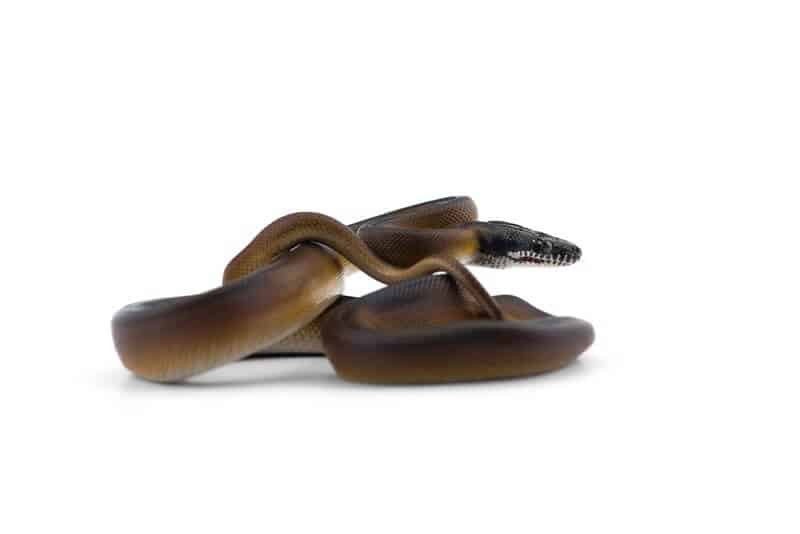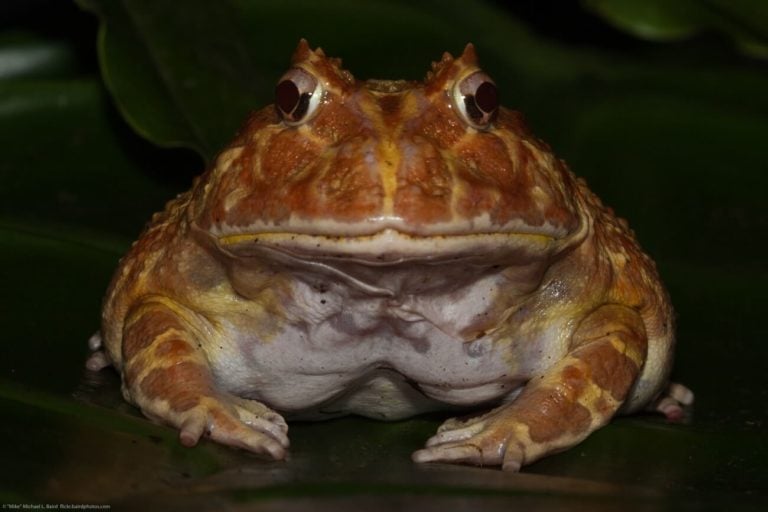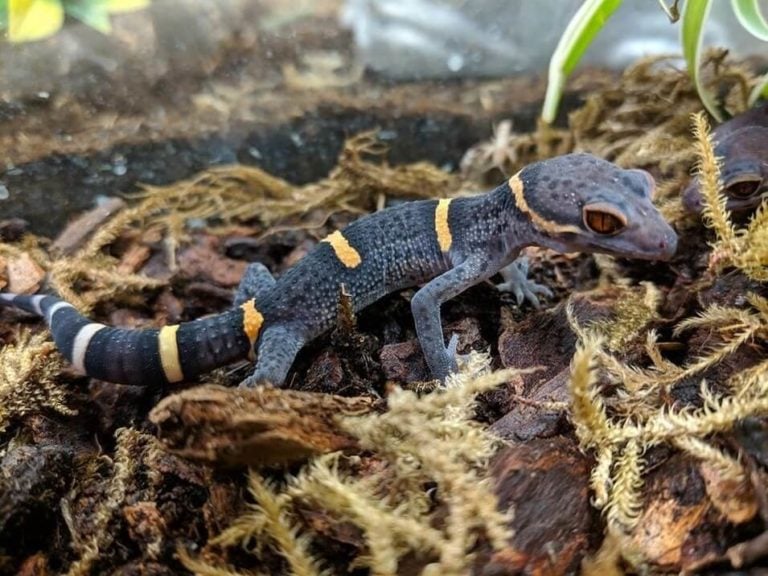White lipped pythons are gorgeous snakes that appeal to many reptile-lovers. However, anyone who is interested in owning one needs to do their homework first!
This guide will teach you everything you need to know about white lipped python care. You’ll learn about their size, enclosure setup, diet, and much more!
Table of Contents
Species Summary
The white lipped python, Bothrochilus albertisii, is a snake that is native to the rain forests of Papua New Guinea. You may also hear this python referred to as D’Albert’s water python, but it’s more commonly known as the white lipped python.
If you’re looking for a pet snake that is easy to care for and has a docile temperament, then you should probably not choose the white lipped python. This python has a reputation for being a bit aggressive and will often bite if it feels threatened in any way.
White lipped pythons are nocturnal hunters and mainly eat small mammals, birds and lizards. After a mammal meal, these snakes will often regurgitate a fur ball, so don’t be concerned if you see your python do this.
Like all pythons, white lipped pythons lay eggs. If you have a pregnant female, you can expect her to lay a clutch of around a dozen eggs.
Appearance & Colors
There are two types of white lipped pythons, and they each have their own unique appearance and coloring. Northern white lipped pythons have a body that’s a mix of golden hues and olive greens, while the southern version tends to be darker brown with hints of purple. In certain lighting, these snakes can have a kind of rainbow iridescence.

As you probably guessed, their name comes from the white scales (called labial scales) that are found above and below the snake’s lips.
Average White Lipped Python Size
Before getting a snake, you should think about the size of the snake that you would be able to care for. Many people purchase an immature snake, and then they are surprised when their cute little snake becomes a monstrous adult. Large snakes require large enclosures, so make sure that you are aware of the average adult size of any snake you may want to bring home.
Male northern white lipped snakes tend to grow to be around five or six feet long, and females, always usually slightly longer, can grow to be around seven feet. Southern white lipped pythons can reach lengths of seven feet, and females can grow to be a whopping ten feet long.
As you can see, these are not small snakes. That’s why caring for one is only possible if you’re able to provide large and roomy enclosures.
Lifespan
Deciding to care for a white lipped python is not something to take lightly. It’s important to remember that once you bring one of these gorgeous creatures into your home, you’ll be responsible for its care for the entirety of its life. You need to make sure that you are prepared to give this snake everything that it needs for many years to come.
The average lifespan of a white lipped python can reach up to 30 years, so taking care of one is a huge commitment. Depending on the kind of care it gets, its living conditions, and its general health, the lifespan of the white lipped python could be even longer. So, if you’re looking for a snake that has the potential to bring years of enjoyment and enrichment, then the white lipped python can certainly provide that!
White Lipped Python Care
White lipped python care is not the easiest task in the world. These snakes tend to be temperamental, and they require very specific conditions. In order for your snake to stay happy and healthy, you’ll need to provide the right enclosure temperature, the right humidity level, proper lighting and a healthy diet. This is a snake for reptile-lovers who have plenty of experience.
It’s also important to understand the temperament of your snake and to be aware of the special health conditions that are associated with white lipped pythons. Remember that you are the pet owner, and the happiness and well-being of your snake is up to you!
Enclosure Size & Dimensions
With a snake of this size, the dimensions of the enclosure you use is very important. Your white lipped python is going to need plenty of room to climb and explore, so you’re going to want to make sure that the enclosure you choose has plenty of vertical space for climbing.
For an adult white lipped snake, we recommend using an enclosure that is about 48 inches by 36 inches by 24 inches. If you have room and would be able to create a bigger enclosure, that would be even better. What’s important is that your snake feels comfortable and safe. However, larger snakes could easily handle an area that’s five feet or larger.
Molded, plastic reptile enclosures are fine to use, but it’s nice if you can have a custom enclosure made. Because white lipped pythons need a pretty high humidity level, don’t use glass enclosures. Stick with plastic because it holds humidity better than glass.
If you have a baby white lipped snake, then you can house it in a ten gallon enclosure until it gets bigger. Once your snake reaches the yearling stage, it can safely be moved to a tank that’s around 36 inches by 18 inches. As with adult white lipped snakes, your baby snake should be housed in a plastic tank. If you decide to use glass, then you’ll need to create a hide that provides extra humidity. Damp moss placed in the hide works pretty well.
What To Put In Their Habitat
Once you get the enclosure set up, it will be time to create your snake’s habitat. When designing the interior of the enclosure, make sure that you try to recreate your snake’s natural habitat as closely as possible. With a little research and a lot of creativity, you can make an enclosure that’s pleasing to both you and your white lipped snake.
The first thing to add to the new enclosure is the substrate. For a white lipped snake, you will need to choose a substrate that will help to maintain the high level of humidity that this snake requires. Some good substrate choices include cypress mulch, coconut fiber, organic topsoil and sphagnum moss. We like to combine some of these substrates for added humidity and visual interest.
Whichever substrate you use, you’ll need to spot clean it every day and deep clean it once a month. Maintaining a clean enclosure is an important step in keeping your pet healthy and happy.
The next thing you’ll want to add to the enclosure is some form of a hide. White lipped snakes love to curl up in areas where they feel safe and secure. You can buy a snake hide at a pet store, or you can make one with an empty cereal box or other similarly-sized box. Hides shouldn’t be too big because these snakes like to feel the sides of the hide against their body.
Expert Tip: Ideally, you should have at least two hides. Place one in the warmer side of the enclosure and one in the cooler side. If you have the space, it’s nice to add a humid hide as well.
While white lipped pythons spend a lot of their time on the ground, they do enjoy climbing. Adding climbing branches, vines or even rope ladders will make your snake feel like it’s exploring the tops of trees in the jungle, and you’ll have the pleasure of watching your snake make the most of the habitat that you create. Your white lipped python will also enjoy small branches and climbing rocks in the enclosure.
Adding a variety of tropical plants will not only add to the aesthetic appearance of the enclosure, but it will also help to maintain the proper level of humidity. Some good plants to try are bromeliads, orchids, spider plants, ferns and golden pothos.
You’ll also need to provide a water area where your white lipped python can submerge itself. However, we will discuss this in more detail later on.
Temperature & Lighting
White lipped python care can get a little more complicated when it comes to figuring out the temperature and lighting for the enclosure. Because snakes can’t regulate their own body temperature, you’re going to have to set up what’s known as a thermal gradient. This means that the enclosure will need to have an area where your white lipped python can go to raise its body temperature and an area where it can cool down. You’ll also need to create a basking area for your python.
There’s very little fluctuation allowed when it comes to the optimal temperatures for your enclosure, so setting up and monitoring thermometers is going to be important.
The warm side of the enclosure should remain between 85 and 90 degrees Fahrenheit, and the cooler side should not drop below 75 to 80 degrees Fahrenheit. Some people will let the nighttime temperature dip to as low as 65 degrees, but this is not mandatory. As for the basking area, we recommend that you keep it at a toasty 95 degrees Fahrenheit.
The best way to provide this thermal gradient is a common topic of debate. Some people feel that it’s sufficient to use incandescent bulbs or halogen bulbs in order to provide heat from above. They feel that this is the optimal way because it mimics sunlight. If you decide to go with this method, then make sure that the lights are only on for 12 hours per 24 hours.
Others feel that it’s best to use heat mats or heat tape that are placed at the bottom of the enclosure. In our opinion, the use of heat mats is not always the best way because they only heat up the bottom of the enclosure, and the top may not reach the required temperature.
Even though white lipped pythons don’t really need supplemental UVB lighting, it’s perfectly fine to add this type of lighting if you wish.
Humidity
In the wild, white lipped pythons live in very tropical, humid conditions, so you will want to keep the enclosure between 60 and 80 percent humidity.
How do you accomplish this? You need to use a substrate that will hold in the humidity. We already discussed the best kinds of substrates to use, but you may have to play around with it a bit to see which combination of substrates works best.
This snake’s thin skin makes dehydration a concern, so you’ll want to monitor the humidity level on a regular basis. While you want the enclosure to remain humid, you don’t want it to be overly wet. Substrates that get too wet will cause scale rot and other issues, so it’s good to let the substrate dry out every so often.
There are a few ways that you can keep the humidity level high. You can mist the entire enclosure a few times a week, or you can set a small bowl of water under the heating device to create humidity.
As we talked about earlier, live plants are a nice way to keep the level of humidity where it should be. Plus, live plants make the enclosure look nicer, and your white lipped python will feel safer and more at home.
Water
White lipped pythons need plenty of clean water in order to remain happy and healthy. Since they are known to go into rivers in their native Papua New Guinea, it’s nice to give them a spot in the enclosure that’s big enough for them to submerge completely.
Make sure that you are giving your white lipped python fresh water every day, and the entire water container should be thoroughly cleaned once a week. However, if your python goes to the bathroom in its water, then everything should be cleaned as soon as you can.
Food & Diet
White lipped pythons do very well on a diet of frozen or freshly killed rats. Don’t be tempted to place live prey in the enclosure because live prey can actually do serious damage to your python. When choosing a rat to give to your python, pick one that is a little bit wider than the widest part of your snake’s body.
If you have a juvenile snake, then you can feed it about once a week. Adult white lipped pythons can be fed every 10 to 14 days.
It’s very important to not handle your snake for a few hours before you are going to feed it. This way it will not associate your handling with feeding time. We recommend placing your snake in a separate enclosure during its feeding time; otherwise it may think it’s going to be fed every time you open the enclosure.
White lipped pythons, like most creatures, can get tired of the same old diet. Feel free to jazz things up with quail, young chickens, guinea pigs or young rabbits.
Potential Health Issues
In general, white lipped pythons are considered to be pretty hardy snakes. Most of the potential health issues are things that can be prevented through careful care and handling. However, health concerns can crop up, and that’s why you need to partner with a veterinarian who has experience with exotic animals.
If you notice that your python is hanging out in its water area more often than usual, then it could be suffering from mites. Look at the water to see if you find little, black dots floating in the water. If so, you can treat your snake with an over-the-counter medicine. Washing your hands and keeping the enclosure clean will help to prevent a mite infestation.
Respiratory infections, caused by fluctuation in temperature, stress or a dirty enclosure, can be very serious. Take your white lipped python to the vet right away if you notice labored breathing or discharge from the mouth or nose.
Overfeeding and a lack of climbing opportunities can cause your python to become obese. As with humans, obesity can lead to a number of health issues.
Finally, scale rot is often a problem if the enclosure becomes too humid or too wet. You’ll know if your python has scale rot if you notice damaged scales or scales that seem discolored. A treatment with over-the-counter creams, antibiotics or even surgery may be necessary.
Behavior & Temperament
White lipped pythons are definitely not known for having sweet, docile natures. These snakes are quite temperamental and are notorious for their bad attitudes and tendency to bite. It’s not that they are purposely aggressive; they are merely exhibiting their natural, defensive nature. This is one of the reasons why we think that only experienced snake owners should attempt to care for a white lipped python.
Even if you start out with a baby that’s born in captivity, you are never going to end up with a snake that enjoys being touched or handled. It’s best to simply accept this snake for what it is and to appreciate its beauty and mystique from a distance.
Handling Them
Your ultimate goal should not be to handle your white lipped python, as much as it should be for your snake to get used to being handled. This may seem to be the same thing, but it’s not.
A white lipped snake is never going to be one of those snakes that will enjoy being handled. The thing you will want to work towards is getting your python used to being gently handled with a snake hook. There are times when you will need to clean the enclosure, move the snake to a separate feeding tank or take it to the vet. Without proper training, these tasks could end up with you getting bitten.
Patience is the key to getting your python used to being handled, and it’s best to try short, calm sessions where you gently handle your snake. Even with time and patience, the chances are very good that you might receive a little bite or two.
Washing your hands before handling your snake will help to keep you from smelling like prey, and a snake hook should always be used while training and handling your snake. A white lipped python will give a quick, sharp nip as a defensive reaction, but it will bite hard and hold on if it thinks that your hand is food.
The final result should be a snake that can become comfortable enough around you to not bite or act defensively. Remember that white lipped python care is more about appreciating its beauty and unique personality than it is about having a snake that tolerates handling.
Conclusion
Now that you’re familiar with what white lipped python care entails, it’s up to you to decide if owning one is something you really want. These snakes require a lot of experience, space, and work!
If you have questions about this stunning species, send us a message. We’re always happy to help our readers.


